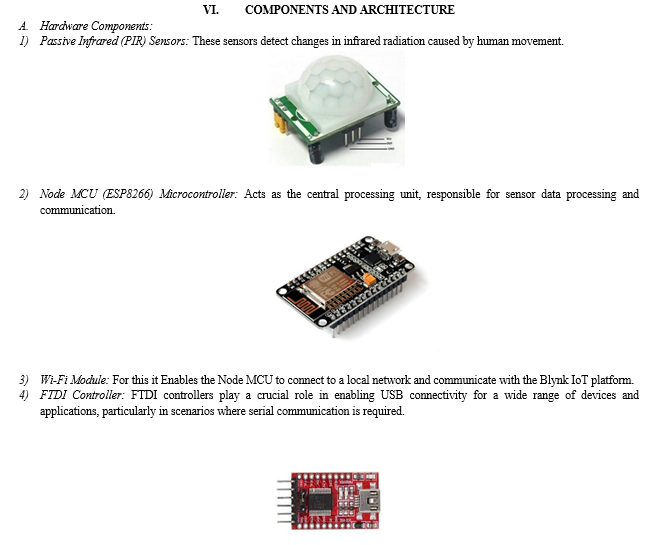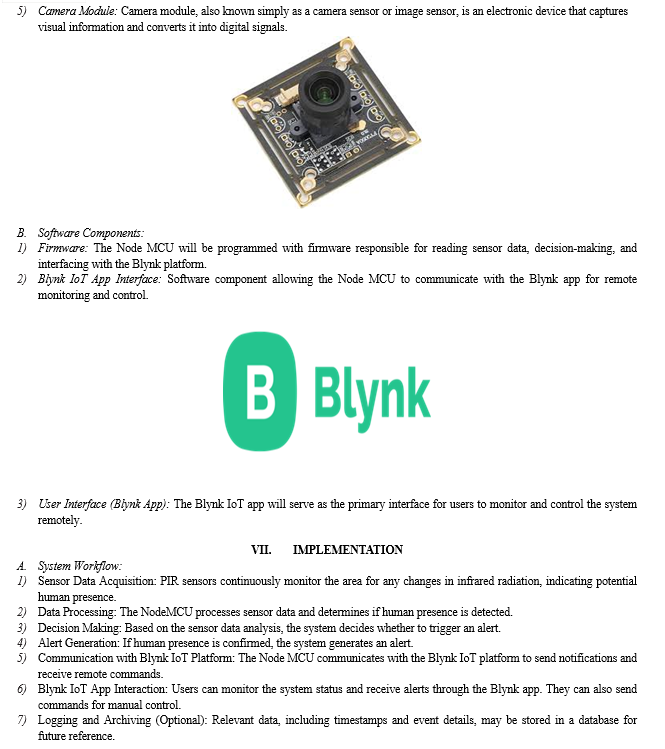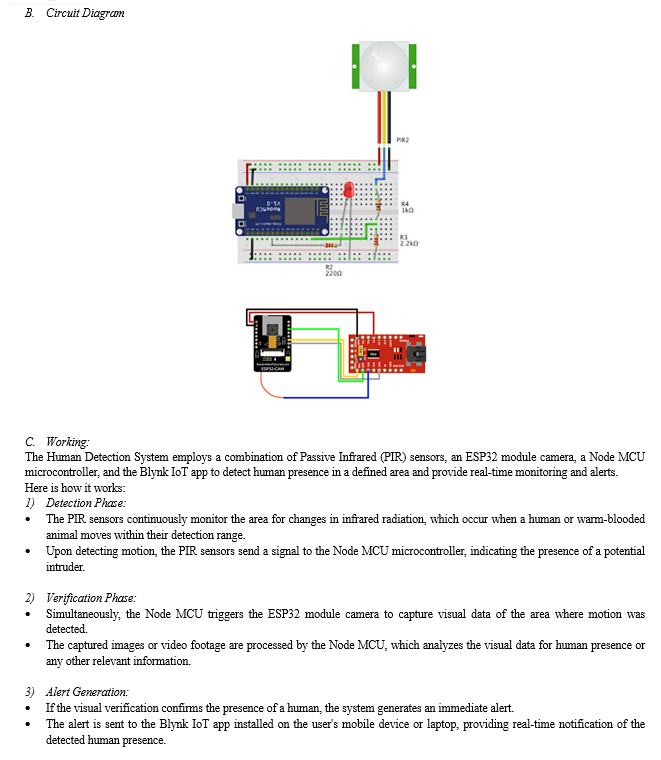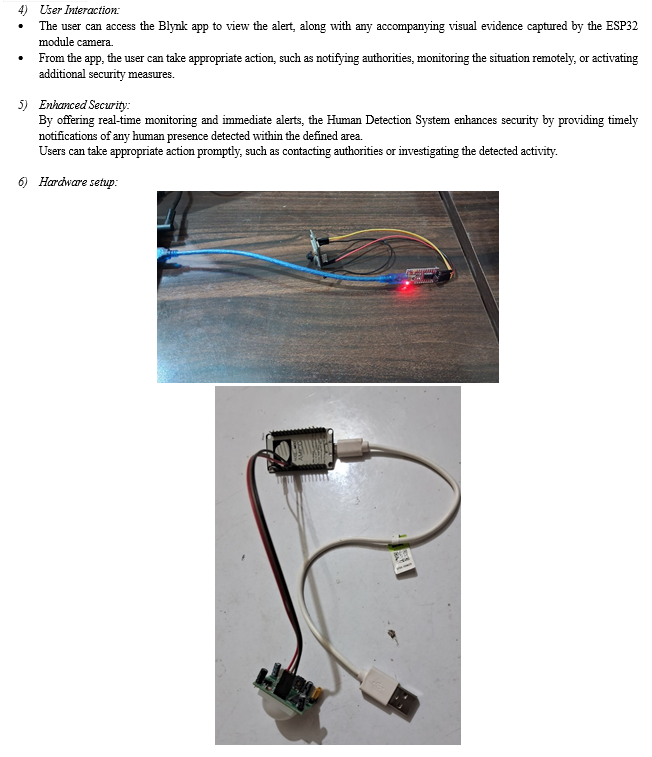Ijraset Journal For Research in Applied Science and Engineering Technology
- Home / Ijraset
- On This Page
- Abstract
- Introduction
- Conclusion
- Copyright
Human Detection for the Betterment of Security System Using PIR Sensor and BLYNK App
Authors: Dr. AY Prabhakar , Snehal Prusty , Satakshi , Aniket Navnath Nawale
DOI Link: https://doi.org/10.22214/ijraset.2024.61129
Certificate: View Certificate
Abstract
The Human Detection System (HDS) presented in this project utilizes Passive Infrared (PIR) sensors, Node MCU microcontroller, and the Blynk IoT app to detect human presence in a designated area, providing real-time monitoring and instant alerts. Additionally, an ESP32 module camera is integrated into the system to visually confirm detected events. Upon sensor activation, the ESP32 camera captures footage of the area, allowing users to verify the validity of the alert via a provided link accessible on mobile or laptop devices. This comprehensive approach enhances security measures by combining both sensor-based detection and visual confirmation capabilities, offering an effective solution for surveillance applications.
Introduction
I. INTRODUCTION
In an era where security concerns are paramount, technological innovations play a pivotal role in fortifying surveillance systems. The Human Detection System (HDS) stands as a testament to the fusion of cutting-edge hardware and software, aimed at enhancing security measures through intelligent detection and verification mechanisms.
The HDS project leverages the capabilities of Passive Infrared (PIR) sensors, Node MCU microcontroller, and the Blynk IoT app to create a robust detection framework. Designed to detect human presence in predefined areas, this system offers real-time monitoring and immediate alerts, ensuring swift response to potential security threats.
Recognizing the importance of visual confirmation in security applications, the HDS integrates an ESP32 module camera into its framework. This addition enables users to validate detected events by providing visual evidence of the area in question. By accessing a live video feed through a link on mobile or laptop devices, users can ascertain the authenticity of alerts, thereby minimizing false alarms and optimizing security operations.
Through the amalgamation of sensor-based detection and visual verification capabilities, the HDS transcends conventional surveillance systems, offering a comprehensive solution to security challenges. In this introduction, we delve into the architecture, functionality, and potential applications of the HDS, highlighting its significance in modern security infrastructure.
II. RELATED WORK
- The document discusses the development of a Human Detection System using IoT for disaster management. It highlights the need for disaster risk management activities to enhance resilience and reduce the impact of disasters. The system uses technologies like microwave radar sensors, IoT, and cloud-based monitoring to detect and locate human presence in disaster-stricken areas. This system aims to improve the speed and effectiveness of rescue operations, potentially reducing casualties. The document also provides a literature survey on IoT-based human detection systems for disaster management, incorporating components like microcontrollers, sensors, cameras, and communication modules. The experimental results validate the effectiveness of the system, highlighting its potential to save lives and improve rescue efficiency. The extensive literature survey provides insights into related research and projects, and the experimental results validate the system's effectiveness.
- The document presents a "Home Automation Security System Based on Face Detection and Recognition Using IoT" that uses face detection and recognition technology integrated with the Internet of Things (IoT). The system captures a person's face, compares it with a database, and grants access to authorized users via a mobile application. In case of unauthorized access, it captures the intruder's image, notifies authorities via email, and generates an alarm. The system is designed for low-cost monitoring and control of access to various premises, including houses, banks, and universities. The document emphasizes the importance of face recognition as a key security measure and the limitations of traditional security methods.
It provides a comprehensive literature review, comparing the proposed system with existing methods and technologies, and outlining the key components and functionalities of the system. Real-time testing is presented using a prototype hardware setup, and the system's accuracy, low-cost nature, and potential applications beyond home security are also discussed.
3. The document discusses the development of a Human Detection System using IoT for disaster management. It highlights the need for disaster risk management activities to enhance resilience and reduce the impact of disasters. The system uses technologies like microwave radar sensors, IoT, and cloud-based monitoring to detect and locate human presence in disaster-stricken areas. This system aims to improve the speed and effectiveness of rescue operations, potentially reducing casualties. The document also provides a literature survey on IoT-based human detection systems for disaster management, incorporating components like microcontrollers, sensors, cameras, and communication modules. The experimental results validate the effectiveness of the system, highlighting its potential to save lives and improve rescue efficiency. The extensive literature survey provides insights into related research and projects, and the experimental results validate the system's effectiveness.
4. The document "Alive Human Detection and Health Monitoring Using IoT Based Robot" explores the development of an IoT-based rescue robot for monitoring the health of trapped individuals in disaster scenarios. The robot integrates sensors like ultrasonic, PIR, and GPS, along with a Wi-Fi module for communication. It navigates through obstructed areas, detects human presence, monitors health parameters, and transmits vital information to rescue teams via an IoT platform. The authors compare the proposed system with existing methods, highlighting its advantages and limitations. The system architecture includes an Arduino Mega 2560, Wi-Fi camera, GPS module, and various sensors. The robot's implementation, working principle, and results are discussed, with potential applications in military rescue operations, borewell accidents, and forest areas. The document concludes by highlighting the significance of the IoT-based rescue robot and its potential for further improvements in range and efficiency.
III. LITERATURE SURVEY
- Passive Infrared (PIR) Sensors in Security Systems
- PIR sensors are widely used in security systems for their ability to detect human movement based on changes in infrared radiation.
- Studies have shown their effectiveness in various security applications, including intruder detection and occupancy sensing.
2. Node MCU and IoT Integration
- The Node MCU microcontroller, based on the ESP8266, has gained popularity for its ease of use and compatibility with IoT platforms.
- Research has demonstrated successful implementations of Node MCU in various IoT projects, including security systems.
3. Blynk IoT Platform
- The Blynk app provides a user-friendly interface for controlling and monitoring IoT devices remotely.
- Research indicates its wide adoption in IoT projects for its intuitive design and compatibility with various microcontrollers.
4. Remote Monitoring and Control in Security Systems
- Studies have highlighted the importance of remote monitoring and control in modern security systems for increased accessibility and responsiveness.
IV. PROBLEM DEFINITION
A. Background
The Human Detection System (HDS) is a response to the limitations of traditional security measures, which often rely on manual surveillance and basic alarm systems. With advancements in sensor technologies like Passive Infrared (PIR) sensors and microcontrollers, coupled with the rise of IoT platforms, there is a growing opportunity to create more sophisticated and effective security systems. The HDS integrates these technologies, aiming to provide real-time monitoring and immediate alerts upon detecting human presence. Additionally, by incorporating an ESP32 module camera for visual confirmation, the system seeks to reduce false alarms and enhance security response capabilities.
B. Problem Statement
The current challenge lies in developing an efficient and reliable Human Detection System that leverages the capabilities of Passive Infrared (PIR) sensors, Node MCU microcontroller, and the Blynk Internet of Things (IoT) app. This system should be able to:
- Accurately Detect Human Presence: Utilize PIR sensors to reliably detect human presence within a defined area.
- Provide Real-time Alerts: Trigger immediate notifications when human presence is detected, ensuring swift response in case of security breaches.
- Enable Remote Monitoring and Control: Integrate with the Blynk IoT app to allow users to monitor the system status and receive alerts remotely, as well as provide manual control options.
- Ensure Energy Efficiency: Implement power-saving techniques to prolong the system's operational lifespan, reducing the need for frequent maintenance.
- Integrate with Existing Infrastructure: Ensure seamless integration with existing security measures to enhance overall security capabilities without the need for a complete overhaul.
C. Justification
The Human Detection System with Visual Verification addresses critical shortcomings in traditional security systems by offering enhanced accuracy, real-time monitoring, and visual confirmation capabilities. This innovative solution empowers users with heightened situational awareness and enables prompt responses to security threats, thereby improving overall security effectiveness. With its remote accessibility feature and scalability, the system ensures continuous surveillance and adapts to diverse security environments. In summary, the significance of this problem statement lies in its ability to provide comprehensive and proactive security measures, ultimately contributing to the creation of safer and more secure environments.
D. Significance
By overcoming the limitations of traditional systems and offering enhanced accuracy, real-time monitoring, and visual confirmation, this system significantly improves security effectiveness.
It empowers users with heightened situational awareness, enabling prompt responses to security threats and proactive mitigation measures. With its remote accessibility feature, the system ensures continuous surveillance and peace of mind, while its scalability and adaptability make it suitable for diverse security environments.
E. Outcome
The ultimate goal of this project is to deliver a fully functional and reliable Human Detection System that meets the defined objectives. This system will provide a valuable tool for enhancing security measures in various environments, contributing to the safety and well-being of individuals and their assets.
V. SCOPE OF THE PROJECT
- Security Applications
- The Human Detection System can be deployed in various security setups, including homes, offices, warehouses, and other controlled access areas.
2. Customization and Scalability
- The system can be customized to accommodate additional sensors or integrate with other IoT devices for comprehensive security solutions.
3. Energy Efficiency
- The project emphasizes power-saving techniques to ensure prolonged operational lifespan, making it suitable for long-term deployment.
4. Integration with Existing Infrastructure
- The system is designed for seamless integration with existing security measures, allowing for enhanced capabilities without the need for a complete overhaul.
5. User-Friendly Interface
- The Blynk app provides an intuitive interface for users to monitor, receive alerts, and control the system remotely, enhancing accessibility and usability.
6. Potential for Future Enhancements
- The system's modular design allows for future enhancements, including advanced machine learning algorithms, additional sensors, and compatibility with other IoT platforms.
The Human Detection System, leveraging PIR sensors, Node MCU, and the Blynk IoT app, addresses the need for an intelligent and accessible security solution. Through research, methodical implementation, and consideration of future possibilities, this project aims to make significant contributions to the field of modern security systems.






VIII. FUTURE ENHANCEMENT
Potential future enhancements may include:
- Implementation of machine learning algorithms for advanced human recognition.
- Integration with additional sensors for comprehensive environmental monitoring.
- Integration with other IoT platforms for broader compatibility.
Continual refinement and expansion of the Human Detection System will ensure it remains at the forefront of security technology, providing clients with cutting-edge solutions for years to come.
Conclusion
1) In conclusion, the integration of the ESP32 camera module with the Human Detection System represents a significant advancement in security technology, offering enhanced capabilities for accurate detection, real-time monitoring, and visual verification of security events. Through the seamless integration of Passive Infrared (PIR) sensors, Node MCU microcontroller, Blynk IoT app, and the ESP32 camera module with FTDI controller, the system provides a comprehensive solution for addressing security concerns in various environments. 2) The addition of the ESP32 camera module introduces new dimensions to the system, allowing for visual confirmation of detected events and reducing false alarms. This not only improves the accuracy and reliability of the system but also enhances user confidence and trust in the security alerts provided. The FTDI controller facilitates efficient communication and data transmission, enabling users to access live video feeds remotely through a user-friendly interface on their mobile devices or laptops. 3) While the integration of the camera module presents challenges such as cost, complexity, and privacy concerns, these can be mitigated through careful planning, technical expertise, and consideration of user needs. Furthermore, the future direction for the system offers promising opportunities for further development and expansion, including advanced analytics, edge computing, cloud integration, and integration with smart home systems. 4) Overall, the Human Detection System with the ESP32 camera module represents a significant step forward in security technology, offering a comprehensive and effective solution for detecting and responding to security threats in real-time. By leveraging advanced technologies and continuous innovation, the system holds great potential to enhance security measures and ensure safety and peace of mind for individuals and organizations alike.
Copyright
Copyright © 2024 Dr. AY Prabhakar , Snehal Prusty , Satakshi , Aniket Navnath Nawale. This is an open access article distributed under the Creative Commons Attribution License, which permits unrestricted use, distribution, and reproduction in any medium, provided the original work is properly cited.

Download Paper
Paper Id : IJRASET61129
Publish Date : 2024-04-27
ISSN : 2321-9653
Publisher Name : IJRASET
DOI Link : Click Here
 Submit Paper Online
Submit Paper Online

